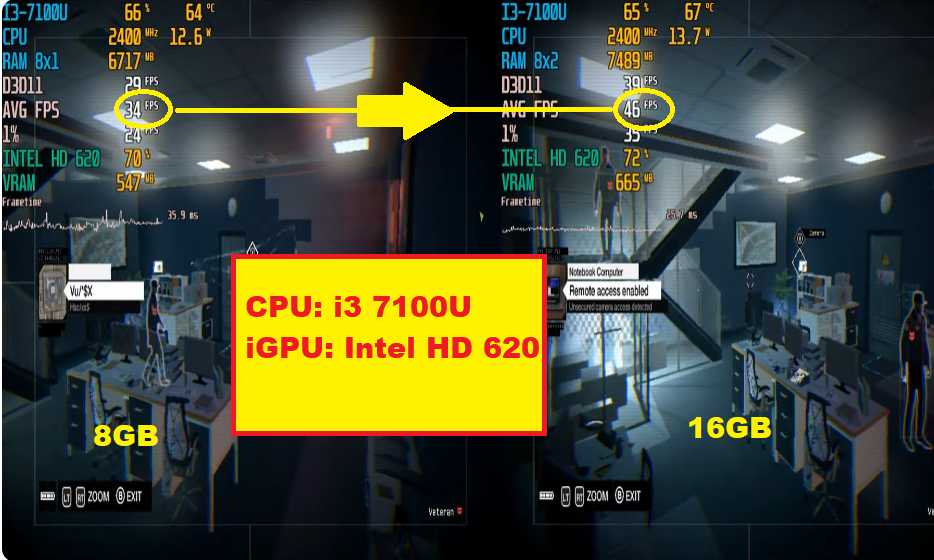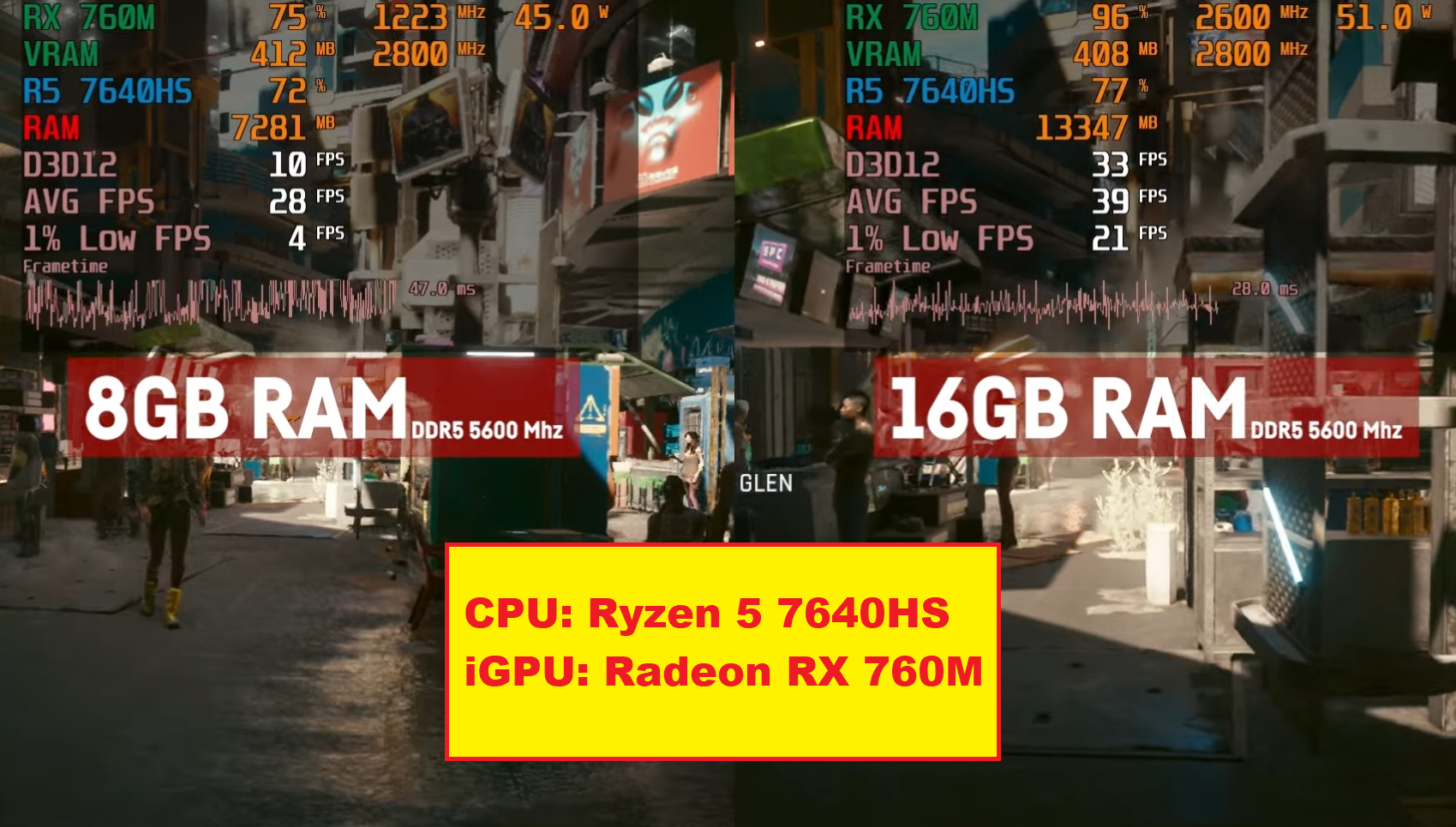8GB vs 16GB RAM for Integrated Graphics (Laptop & Desktop)
Let’s get straight to the point.
The problem with integrated graphics is that it SHARES MEMORY with the CPU.

Having more than 8GB RAM makes sure the integrated GPU can allocate SUFFICIENT MEMORY with no interruptions.
In other words, it won’t have to worry about the CPU taking too much RAM because there will be plenty.
Thus the integrated GPU can run more efficiently.
Now….
What’s the performance difference between 8GB RAM vs 16GB RAM when running on integrated graphics?
Some benchmarks show performance gains up to 35% and others as low as 10%. It depends on the integrated graphics and the game.
Of course, there will be performance gains in other “GPU” dependent software too (CAD, Photo & Video Editing software).
However since most people reading this are gamers. We’ll focus on gaming benchmarks.
Gaming on Integrated Graphics : 8GB vs 16GB RAM
We will go over a bunch of integrated graphics (hopefully cover them all in future posts) to try and find some insights. We’ll go over desktop
Intel HD 2500 (Desktop)
The following game is Hitman 3 which was released in 2021. The game required a entry level dedicated GPU. Nonetheless An Intel HD Graphics 2500 with a very old CPU was used here: Core i5 3570. That’s a desktop CPU.

Settings: Normal, 1080p
Notice the FPS gain from 8GB to 16GB is only about 6fps. Considering the outdated CPU and low performance graphics card, this is a significant increase (35% increase).
Intel HD 620 (Laptop)
This is a laptop CPU. Thus the integrated graphics is much weaker than the desktop counterpart. The game running below is Watch Dogs 1.
Since the game is quite hardware demanding, the settings are at low.

Settings: Low, 800p
Notice how there’s a 10 FPS again which is a 35% increase in framerates. The exact same performance gain with the desktop integrated graphics we tested before.
Intel UHD 630 (Laptop)
This next case is another laptop integrated graphics but this time the integrated graphics used here is much more recent. It’s a 10th generation Core i3 CPU: Core i3 10100U. The game tested is Fortnite at low settings 1080p resolution.

Settings: Low, 1080p
There’s a fps increase from 30 to 38. That’s about 26%. There’s naturally going to be less performance gains the more recent the iGPU is and the heavier the game is. Fortnite is very graphically demanding and requires much more power because it is an ONLINE multiplayer game.
Despite that, there’s a huge performance gain (26% is quite high for Fortnite). But this is ALSO due to the Dual-Channel RAM set up. To see what that means, read my post here: Dual-Channel For Gaming. Dual-Channel
AMD Radeon Vega 7 (Laptop)
This is a relatively modern integrated graphics found on 4th and 5th gen mobile Ryzen CPUs. In this case, the Ryzen 5 5500U. This is a good benchmark because this CPU is still relevant in 2024 for gaming at low settings 1080p resolution.
The game tested below is CyberPunk 2077. The measurements are 8GB, 12GB and 16GB respectively.

Settings: Low, 1080p
Note the FPS gains goes from 21 to 30. That’s almost a 50% increase. The performance gains is the same for the average: 17-28. About 50% increase. These are much higher gains than the Intel benchmarks and as you’ll see soon this is going to be a common pattern for more recent iGPUs and not so much for older iGPUs.
AMD Radeon RX 760M (Desktop)
The following game is ALSO CyberPunk.
Though it’s running on a very modern desktop CPU ( Ryzen 5 7640HS) the framerates are low because the graphics are integrated despite the settins being set at LOW 1080p.

Settings: Low, 1080p, FSR Quality
Note THE MASSIVE increase in framerates in that snapshot from 10 to 33 fps, that’s about 200% increase. However, on average, the framerates gain are about 40% (it goes from 29 to 39). Note that the RAM used is DDR5 that’s definitely going to give you a bigger boost.
AMD Radeon Vega 8 (Laptop)
This last benchmark is very very important. It’s testing a very OLD CPU with an old integrated graphics: Vega 8. This Radeon Vega 8 is found on 2nd and 3rd generation AMD Ryzen CPUs. The game tested is GTA V and the performance gain is much lower compared to newer models.

Settings: Low, 1080p, FSR Quality
The left is testing 4+4GB (Dual-Channel), the middle is testing 12GB and the right side tests 16GB (in dual-channel). Note how there’s only a 4 fps gain despite the game running at the lowest settings.
Key Points
- It’s a no brainer to do the upgrade. You always see performanec gains.
- There will be higher performane gains with more recent graphics.
- Dual-Channel RAM + 16GB RAM on an integrated graphics brings massive boost.
- DDR5 RAM on AMD integrated graphics will see the highest gains.
Author Profile
- I am physicist and electrical engineer. My knowledge in computer software and hardware stems for my years spent doing research in optics and photonics devices and running simulations through various programming languages. My goal was to work for the quantum computing research team at IBM but Im now working with Astrophysical Simulations through Python. Most of the science related posts are written by me, the rest have different authors but I edited the final versions to fit the site's format.
Latest entries
 wowDecember 18, 20255 Best Laptops For World of Warcraft – Midnight & Classic (2026)
wowDecember 18, 20255 Best Laptops For World of Warcraft – Midnight & Classic (2026) LaptopsDecember 17, 2025The 4 Best Laptops For Virtualization of 2026 (10-50 VMs ATSM)
LaptopsDecember 17, 2025The 4 Best Laptops For Virtualization of 2026 (10-50 VMs ATSM) Hardware GuideDecember 17, 20252026 Beginner Guide to Reading Computer (Laptop) Specifications
Hardware GuideDecember 17, 20252026 Beginner Guide to Reading Computer (Laptop) Specifications LaptopsJune 30, 2025Best Laptops for Computer Science (July 2025 )
LaptopsJune 30, 2025Best Laptops for Computer Science (July 2025 )
